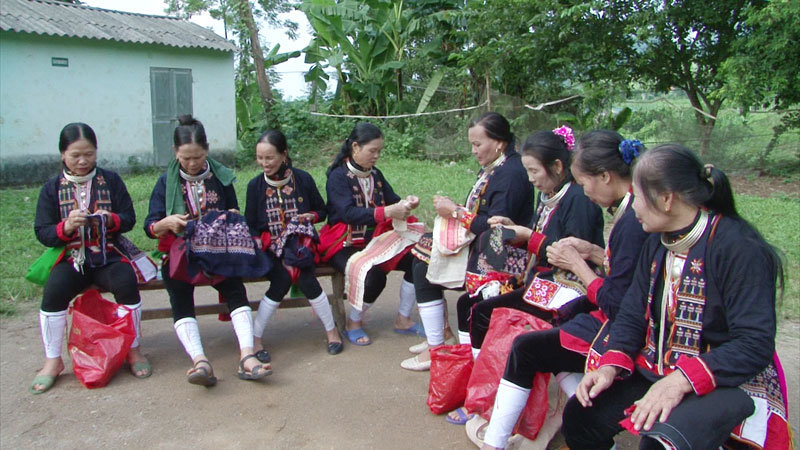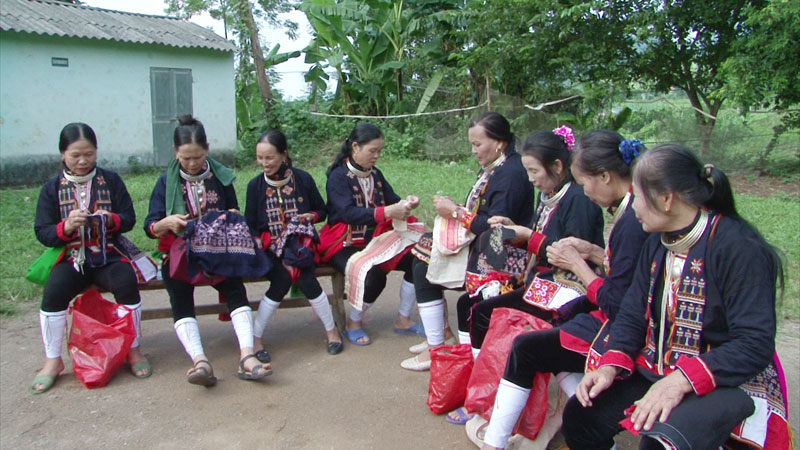
(HBO) – Hoa Binh province is home to two Dao ethnic minority groups, namely Dao quan chet and Dao tien, who mainly live in Da Bac, Kim Boi, Cao Phong, Mai Chau, Ky Son and Luong Son districts, and Hoa Binh city.

Clothes
of the Dao groups are decorated with unique patterns on the background of
indigo colour, with a harmonious combination of accessories like scarves and
jewelries. Dao quan chet women boast a special dressing style as their trousers
are tightened to their legs.
Ban
Sinh Luong, a prestigious elderly in the Dao quan chet community in Dong Chua
hamlet, Thong Nhat commune, Hoa Binh city, said Dao people still wear their
traditional costume during the Tet festival, weddings and funerals.
Apart
from shirts and pants, Dao women also put on other accessories such as
brassieres, headscarves, silver necklaces and belts.
It
is noteworthy that Dao quan chet people do not practise weaving and they have
to buy fabric to make clothes. However, they weave belts themselves and embroider
them with colourful patterns. The art of fabric decoration has been preserved
among the community, and girls have to learn these skills from their mothers,
grandmothers, other family members and villagers at a fixed age.
Dao
quan chet women do not wear skirts but pants (Hau) that are made of indigo
fabric ending below knees and tightened to legs. Pant cuffs are decorated with
patterns and edges are stitched with colourful threads.
Of
note, Dao quan chet women wrap their calves with xa cap (chay keo) made of
white fabric clockwise.
Another
important accessory of Dao quan chet women is the scarf (called Coong pe song
in local language), made of three layers of black fabric whose ends are decorated
with floral patterns, eight-pointed stars and "Longevity” letter.
Unlike
women, Dao men’s costume is simple, comprising shirts (chang lui), trousers
(chang hau) and scarves (goong xong) of indigo or black colours.
To
preserve the traditional costume and culture, the provincial People’s Committee
has devised a project on building a centre protecting culture of the Dao quan
chet ethnic minority group in Thong Nhat commune in service of community-based
tourism. The project has also helped locals raise their income and living
standards./.
The clothing of women reflects the culture of the Muong, Thai, Tay, Dao, and Mong ethnic groups in the northern province of Hoa Binh.
Gongs hold a special place in the cultural and spiritual life of the Muong ethnic people in Hoa Binh province. More than musical instruments, they are an indispensable part of community rituals and collective memory, echoing through generations as a spiritual thread linking the past, present, and future.
Preserving and promoting the cultural values of the Muong ethnic group has become an urgent task in the current context, as many traditional values face the risk of fading away. This effort requires not only protecting the cultural identity but also eliminating outdated customs and developing a modern cultural lifestyle, contributing to sustainable values for the Muong community in Hoa Binh province.
The Muong ethnic culture, deeply rooted in Vietnam’s mountainous north, continues to be preserved and revitalised by dedicated individuals and communities determined to safeguard their ancestral identity.
The Muong group is one of the largest ethnic minorities in Vietnam, primarily found in Hoa Binh province. The Muong people in Hoa Binh boast a rich and diverse cultural treasure that reflects the unique identity of this ethnic group. Accounting for over 63% of the province's population, they have created and preserved numerous distinctive cultural values, contributing to their unique identity. Their cultural heritage is an invaluable asset, at the heart of their national identity, and represents a vibrant spiritual life that must be preserved and promoted in today’s modern world.
For generations, the ethnic communities of Hoa Binh province, particularly the Muong people, have preserved vibrant festivals deeply intertwined with the region’s geography, nature, and social traditions. These celebrations enrich Hoa Binh’s spiritual life and cultural identity, reflecting both folk beliefs and the intermingling of ethnic customs. Many of these festivals have endured the test of time, passed down through generations and continuing to thrive today. Among them, the Khai Ha (Going Down to the Field) festival stands out as one of the most significant events of the Muong ethnic group.



